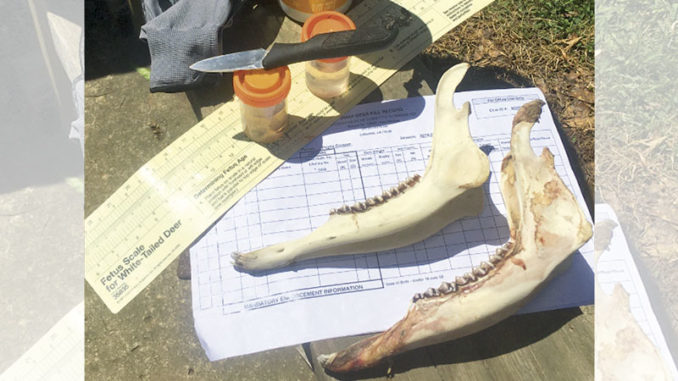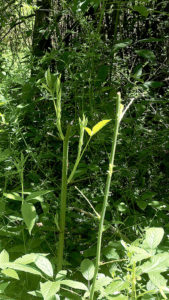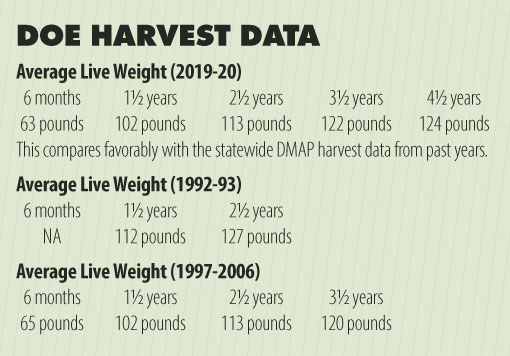
Harvest figures, growth rates, antler size should be examined to see if management is working.
The 2019-20 deer season ended two months ago, and it’s time for biologists to look at harvest data and evaluate the condition of the deer herd being managed. However, because of Covid-19 pandemic, this work may have been put on hold.
As a club or landowner, you probably should be examining your data now that spring green-out is well under way. Last year, a wet spring made for ideal growing conditions for browse, and this should have had a positive impact on the condition of the deer and should be reflected in the data. The mast crop was fair, and this, too, should have benefited the deer and should be reflected in the data.
This year, we experienced a very mild January that initiated our early green-out. Browse conditions are excellent, and it’s time to be out looking at the browse. From what I have seen on our property here in East Feliciana Parish, deer are eating the choice browse species. This early spring growth is quality nutrition for bucks and does and should complement body and antler growth and pregnancy.
How old, how big?
Age and growth studies are a must for any game-management work. In the fall, biologists collect dove wings from hunters to determine the number of juvenile and adult birds that were harvested. This will provide information about reproduction and nesting success. Biologists will check hunters during squirrel season to identify the percentage of males and females in the harvest, along with the number of spring-born and summer-born squirrels.
Deer biologists will examine jawbones to determine the age of harvested deer, to go along with body weight, antler growth and reproduction. Growth trends can then be established, and over time, they will reveal whether the management program is working or needs tweaking. Deer herds are impacted by the harvest effort and by the habitat and management work being applied to the habitat. If the work is doing what it should, growth and development should be good.
Things to keep in mind

A word of caution regarding the data. Harvest effort can somewhat bias the data. Many clubs and landowners choose to harvest only top-end bucks. These bucks may represent only 10% of the buck population and may not give a clear picture of the actual growth trends. Likewise, many programs do not harvest 6-month-old deer, and some restrict the doe harvest, thus the data set is not really complete. I have always thought it best to harvest deer from all age classes, which should provide a good data set and allow biologist to get a clear picture of what is going on in the herd. This type of harvest occurs every season on public lands, and the data sets from WMAs are a good reference source.
I have been working with a DMAP club in Area 6 for about 10 years, and the harvest data is used to make annual recommendations regarding the management program. The habitat is bottomland hardwood with available agricultural crops, corn, soybeans and winter wheat. This is the type of habitat that produces the big bucks that hunters desire. The buck harvest on this property is somewhat selective, so the doe harvest provides the best information about growth and development. Because of the excellent forest habitat and agriculture, one would expect growth trends to be good.
Charting does
The 1992-93 data indicates does were somewhat heavier; in fact 1½-year-old does averaged 10 pounds more than those from recent seasons. The heavier a deer is when it is young, the better growth and development it will have as it grows older. Yearling (1½) bucks that average 125 pounds will be larger in the older age-classes than yearlings that average 110 pounds and may have larger antlers also. Reproduction will also be higher; heavier does are the best producers and mothers.
 For this type of habitat, with all the available agriculture, I really believe the does on this tract should weigh more. A factor that may be having an impact is that on the large tract that joins this one, very few does are harvested. Consequently, does that are harvested are quickly replaced with the neighbors’ does, so growth trends are not quite what I would like to have.
For this type of habitat, with all the available agriculture, I really believe the does on this tract should weigh more. A factor that may be having an impact is that on the large tract that joins this one, very few does are harvested. Consequently, does that are harvested are quickly replaced with the neighbors’ does, so growth trends are not quite what I would like to have.
As previously mentioned, biologists will do the same type of examination with antler data, lactation rates and other collected data. With these stay-at-home orders, now is a good time to look at your data and do some ciphering.
If body weights and antler growth are poor, it may be due to habitat issues. If browse availability is low, it may be time to do some timber work. So if possible, plantings may help to some degree, as would supplemental feeding, but that gets expensive. If the browse survey reveals high browsing pressure on the desirable browse species — which results in the lesser quality browse species being eaten — it may be time to stock up on bullets for next year and reduce the number of mouths on the landscape. Be safe, keep your distance while extending brotherly love and have a great summer.


